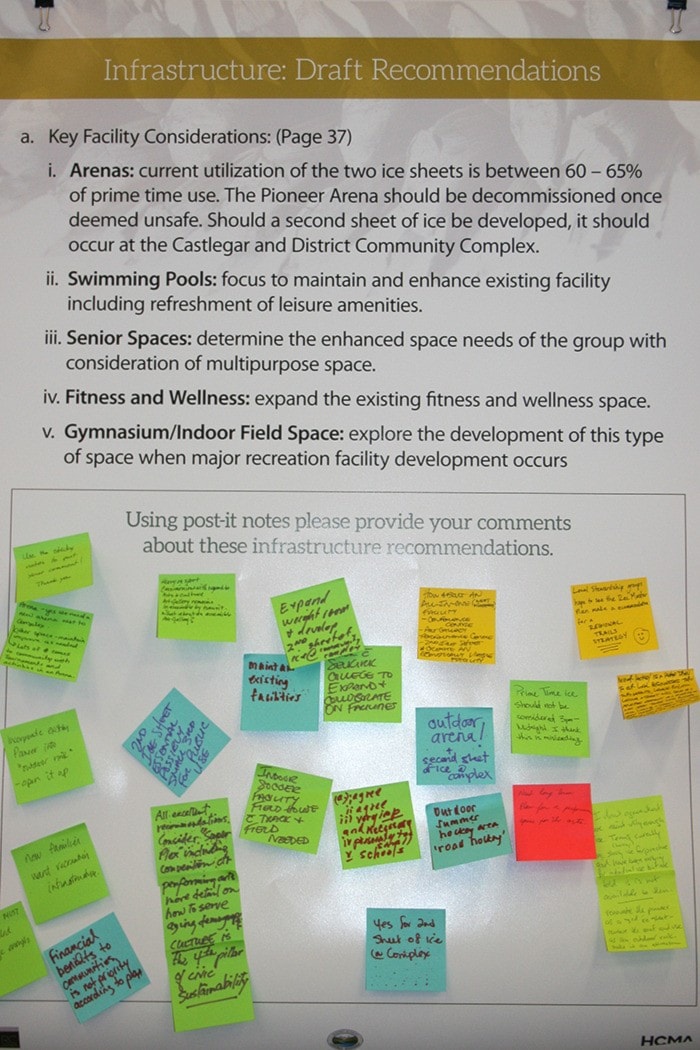The Castlegar and District Recreation Commission (CDRC) revealed the draft version of its new master plan at an open house on Tuesday. The plan has been in development for about a year and is the result of research, public input, data gathering and the analysis of that information.
CDRC is a regional partnership between the city of Castlegar and Regional District of Central Kootenay Areas I and J. Representatives from all three groups sit on the commission. Consulting firm RC Strategies was hired to do the research and put together the report. The CDRC plan only covers areas that are under the authority of the commission, this includes the Castlegar and District Community Complex and regional facilities. Areas that are run by the city of Castlegar are not included.
Residents returned 792 surveys, which was considered a good number. RC Strategies consultant Mike Roma explained, "Statistically significant would have only been 400. So we are doing really good." Seventeen community groups filled out the group questionnaire and 11 stakeholder consultations occurred with a total of 51 participants.
The purpose of the plan is to help the commission with focus, direction and setting priorities which in turn will help them make decisions about future projects. This is just the draft stage of the plan, it does not mean that everything on it will eventually happen. "The master plan is a tool to help decision makers make a decision. It is not a policy or law," said Roma. Master plans are designed to be useful for many years, most have about a 10 year life span according to Roma.
To determine the priorities, a weighted point system was used balancing public demand, social good and public accessibility, cost savings through partnerships or grants, current provisions in the area, economic impact, overall capital cost and overall operating cost. Based on those things the top five indoor priorities were listed as a walking/running track, fitness/wellness facilities (exercise/weight room), indoor field facilities, gymnasium spaces and ice arena facilities. The top four outdoor priorities were a walking trail system, interpretive trails, picnic areas and amphitheatres/event spaces.
As for the Castlegar Complex, priorities and cost estimates were given as: fitness/wellness upgrades $4.2 million, aquatics upgrades $6.2 million, ice arena and walking/jogging track $11 million, multi purpose/seniors addition/arts $2.4 million, field house/walking/jogging track $8.7 million. The plan gives direction on how to accomplish these goals, but does not make the decision as to which ones get done."Whatever they decide to do, they will have the ideal strategy related to it, the prioritized consultant perspective, input from the public and capital and operating cost implications," said Roma. "But they will still have to decide what to do."
Many of the expansion options in the plan would require going to a referendum because of their expense. A previous recreation expansion referendum held in 2010 failed.
Castlegar mayor Lawrence Chernoff, who sits on the CDRC was at the open house and was pleased with the good turnout. "It gives people all the information they need to have. The comments are great," he said. "They have an opportunity to have a say. That is what we have always looked for, you have a say and affect the decisions that come down the line."
People attending the open house were able to place comments and questions directly on the displays in the form of post-it-notes and were invited to fill out a feedback form. The entire draft plan and a feedback form can be found at www.rdck.ca under the services tab.
